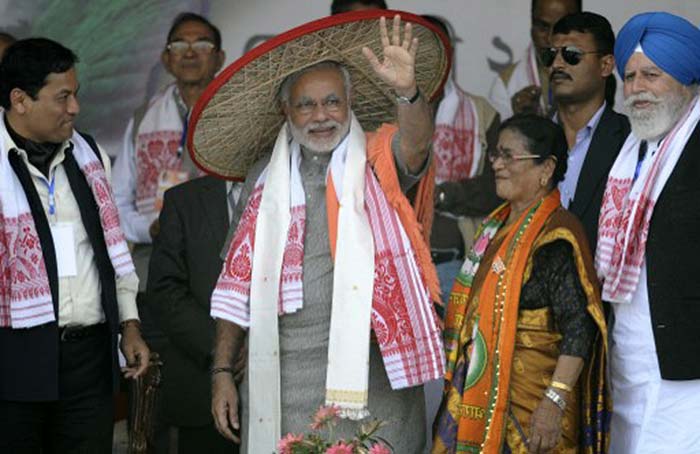
Post 2014’s general assembly elections, the nature of Indian politics has changed significantly. The Congress party is facing decline, not just at the Centre but in many states as well, due to the rise of the Bharatiya Janata Party (BJP), and the end of alliance formation. Whether the Congress is doing enough to resurrect itself will be tested in Assam and Kerala in April, two of the five state assembly elections in 2016. But much to the party’s discontent, this will be hard to do without alliance formation at the state level. If the Congress resuscitates its strong base in Assam and Kerala, despite the anti-incumbency sentiment, it will survive. Otherwise, the magnetism of the ‘Modi wave’, if it still exists, will score another win for the BJP.
Assam
Assam is a highly polarized state, and thus provides fertile ground for the BJP to spread. The BJP did well in Assam in the 2014 general assembly elections, raising people’s expectations. But Assam is very different now from what it was two years ago. People are still waiting for the BJP to fulfill the promises it made then. The Lower Subansiri hydel project, which is expected to cause environmental damage, was opposed by the BJP during the 2014 campaign. But much to the resentment of the people of Assam, the project is still ongoing. Similarly, the party also promised to protect Assam’s land, but as soon as the BJP came to power, it passed the Land Boundary agreement, thereby consigning a share of Assam land to Bangladesh. Third, the Assam Accord, signed during the Rajiv Gandhi government, is yet to be implemented. Illegal immigration from Bangladesh is also a contentious issue. Unable to fulfill its promises to oust Bangladeshi immigrants from Assam, BJP’s votebank politics seem to have been affected in the state. However, the party claims it is confident that it will be able to win the majority, and is in talks to form an alliance with the United People’s Front (UPF) to contest 30 seats.
In spite of all this, the BJP still has a fair chance in Assam. The Modi government has proposed to grant Scheduled Tribe status to six communities: Moran, Tai Ahom, Muttock, Koch Rajbongshi, Sootea, and Tea—a plan under consideration. This is likely to boost the status of the communities and increase support for the BJP. Since the politics of one state affects another, it is likely that the recent controversy and debate in Arunachal Pradesh over cow slaughter will benefit the BJP by getting more Hindu votes.
The high Muslim population in Assam can, however, swing the vote share in either direction. The BJP is likely to contest the elections in alliance with Bodoland People’s Front and Asom Gana Parishad. These two parties hold the votes of a significant Muslim population. However, there could be a twist if All India United Democratic Front, which holds a majority of the Muslim vote in the state, decides to support Congress. If that happens, BJP’s chances to win Assam look bleak.
Kerala
On the other hand, in Kerala, caste politics are at play. Not just Christian and Muslim supporters of the Congress and Left, but Hindu voters have also made their presence felt. Two prominent parties have ruled Kerala: Congress-led United Democratic Front (UDF) and the Communist Part of Indi-Marxist led Left Democratic Front (LDF).The Congress-led UDF appears confident to retain power in the upcoming elections. The BJP, on the other hand, maintains its traditional vote base of upper caste Hindus, and is likely to form an alliance with The Sree Narayana Dharma Paripalana (SNDP) Yogam, which represents the marginalized Hindu Ezhava community. This might be a little troublesome for the BJP, as the upper caste may not not prefer sharing seats and votes with the marginalized.
Apart from this, the BJP also expects to form an alliance with the Brahmin organization Yogakshema Sabha, fishermen’s organization Dheevara Sabha, and Kerala Pulayar Maha Sabha, representing the Dalit community. The BJP is trying hard to become a key player in Kerala’s electoral politics. The party has never won a single assembly seat or Lok Sabha seat in the Congress or UDF-ruled state. It is often presumed that the communal politics played by the BJP government won’t work in Kerala. It would be interesting to monitor whether the BJP will be able to open its account in Kerala. If it does, one can conclude that not only is the Congress in decline but also the Left.
Conclusion
Both the Congress as well as the BJP would need to play the electoral game discreetly in Assam and Kerala. Winning a majority in state elections is pivotal for the Congress to maintain its existence. At the same time, it’s crucial for the BJP to expand its presence in various states and institute a voter base for the 2019 Lok Sabha elections.
The next two years promise to bring interesting trends in Indian politics. This year, all five elections are in Congress or Left-dominated states. If BJP wins even in a single state, it would be interesting to analyze whether voter behavior was shaped by caste/religion or development considerations. If Congress wins, it may indicate that the BJP has a long way to go before it can fully establish itself nationally. Whatever the case may be, these state elections and the parties’ performance thereafter would likely forecast the outcome in 2019.
***
Image: AFP, Getty